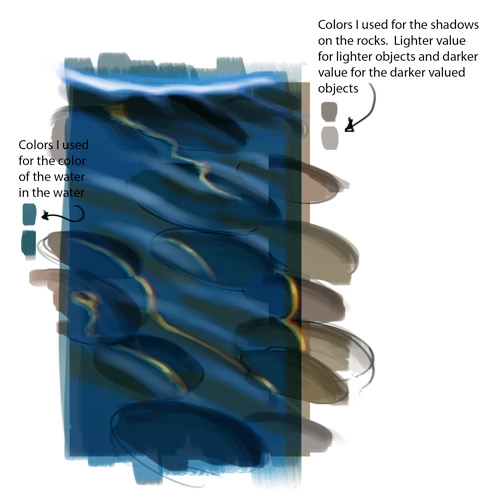
In this new series of articles, San Diego artist and instructor Ron Lemen will explore the science behind what we see, in order to make our paintings more convincing. In each segment, you’ll learn something new about the natural world.
Lemen says he believes direct observation is the key, but understanding the physics behind things only improves one’s ability to depict them. “If you care about the subtext, it will show up in your painting,” says Lemen. “You don’t want to get lost in the science of it. You can still feel everything that you feel. But you will move your hand a little more intelligently if you know the science. You’ll know what it is that you are manipulating, and why. It’s the artist who makes the art.”

The edge of the ripple is considered the dead zone.
Lemen’s first installment deals with water ripples.
I used Photoshop here to explore the science of ripples. I created each effect on a separate layer to learn how water, ripples, refraction (how light is distorted by a surface), and caustic lighting (how light is distorted when it hits curves) work. This is not how you paint. It is a painting method of pure observation, and you can use it as a way of painting, but this would wear down any painter if this were how everything had to be put together. Note that I used two values to paint the color of the water, and two for the color of the shadows on the rocks lying on the bottom.

If it is shallow enough, you will see completely through the surface through all sides of the ripple.
The edge of the ripple at both sides is considered the dead zone to the eye because all of the surfaces are not as extreme in their angles to one another since they are all almost parallel to the view we have of them.

Another view of ripples showing caustic lighting, refraction, and the values of the objects under the surface.
As the clear ripple example indicates, if it is shallow enough you will see completely through the surface through all the sides of the ripple.





This is so poorly written I have almost no idea what the author is trying to say. Consider the sentence: “The edge of the ripple at both sides is considered the dead zone to the eye because all of the surfaces are not as extreme in their angles to one another since they are all almost parallel to the view we have of them. ” All of the surfaces of what? How do surfaces have angles? If I’m looking down, how can “they” (the surfaces) be parallel to our view? And what is the edge of the ripple, anyway? Do you mean both sides of the peak? or the area between ripples? Please edit and say what you mean.
Hello, Evan,
Thank you for commenting; I see that this article was published in 2015 by someone who is no longer with the company. I’m not sure exactly what the artist was trying to express, so I hope that the images at least will offer you some guidance on this topic.
The ripple forms an ellipse on the surface of the water. At the farthest edges of the ellipse as indicated by the red triangles the rise and fall that forms the ripple is nearly parallel with the line of sight. At this small point of the ellipse you don’t see the ripple pattern. The writer terms this point the “dead zone” Also, in the first example of the shallow water, you are able to see the texture of the bottom of the body of water through all sides of the ripple. In order to paint realistic and believable image from direct observation these principles of physics should not be overlooked. He is not advocating filling one’s head with physics; rather, an understanding of light and perception so as to have an informed view. We all hope that looking with an informed eye will result in a more satisfying painting.